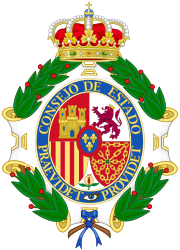Spanish Council of State facts for kids
|
Consejo de Estado
|
|
 |
|
 |
|
| Motto | Praevidet Providet |
|---|---|
| Formation | 1526 |
| Type | consultative body |
| Headquarters | Palace of the Councils, Calle Mayor, 79, Madrid, Spain |
|
President
|
Magdalena Valerio (since 2022) |
|
Budget
|
€ 13.96 million (2022) |
|
Employees
|
140 (31 December 2020) |
The Council of State (in Spanish: Consejo de Estado) is like the main advice-giver for the Spanish Government. It helps the government make important decisions. This council was officially set up in its current form in 1980. This happened because of a special rule in the Spanish Constitution of 1978.
However, the idea of a Council of State has been around for a very long time. It has been helping Spanish rulers since King Charles I created it in 1526. Back then, it mostly gave advice on how to deal with other countries.
Contents
History of the Council of State
The idea of a council that helps rulers manage their lands started a long time ago. In the Crown of Castile, a kingdom in Spain, the Council of Castile was created in 1385. This was done by King John II.
Other kingdoms in Spain also made their own councils. For example, the Kingdom of Navarre created one in 1481. The Kingdom of Aragon also got its own council in 1494.
Foreign Affairs Council (1522–1834)
King Charles I ruled over many lands across Europe. Because he had so many international matters to deal with, he decided to create a new council. This council was called the "Council of State." It started its work in 1526. This was when the Ottoman leader, Sultan Suleiman the Magnificent, was threatening Spanish lands in Austria.
This council was special because the King himself was its leader. Its advisors were not just lawyers. They were experts in how to deal with other countries. Important people like the Duke of Alba were part of it.
The council was very important during the reigns of King Charles I and King Philip II. It also had a lot of power when Mariana of Austria was ruling for her young son (1665–1675). Later, a king named Philip V (1700–1746) made it less powerful.
Unlike other councils, the King would tell the Council of State what to discuss. He would listen to his advisors. Then, the King himself would make the final decisions.
Supreme Consultative Council of the Government (1812–Today)
The Council of State has appeared and disappeared at different times in the 19th and 20th centuries. In 1812, a new Constitution was written. It said that the King had to ask this council for advice on important matters. This included approving laws or deciding to go to war.
However, this rule changed in 1814. King Ferdinand VII came back to power and removed many of the new rules.
After the King died in 1833, the council was ended. A new body called the Royal Council of Spain and the Indies was created. But this new council was also ended in 1836.
In 1845, the council was brought back. It was called the Royal Council this time. For the first time, the Prime Minister became its head. In 1858, it got its original name back. Since then, many laws have guided the council, with the newest one being from 1980.
Today, the Council of State is still the main body that advises the government. However, since 1991, some of its tasks about money and society have been given to the Economic and Social Council.
Current Organization of the Council
The Council of State is located in the Palace of the Councils, Madrid. This building is in Madrid, Spain. The law says that the council is the highest body that advises the Government.
Its main job is to make sure the government follows the Constitution and other laws. It does this by giving advice when the law says it must, or when the government asks for it.
The council has a President. The President is chosen by the Council of Ministers with advice from the Prime Minister. The President also has to speak to the Congress first.
The council also has three types of members called Councilors:
- Permanent Councilors: These members are appointed for life or until they choose to retire. They are chosen from people who have been ministers, regional government leaders, or other important officials. They can also be university professors, military legal officers, or high-ranking civil servants. There are as many Permanent Councilors as there are sections in the Council of State.
- Ex-officio Councilors: These members are part of the council because of another important job they hold. They stay on the council as long as they have that job. This group includes former Prime Ministers (who serve for life), heads of royal academies, the Attorney General, and the Chief of the Defence Staff.
- Elective Councilors: There are ten of these members. They are chosen by the government for four years. They can be former members of parliament, judges, ombudsmen, or mayors of big cities. At least two of them must have been leaders of Spain's regions.
See also
 In Spanish: Consejo de Estado (España) para niños
In Spanish: Consejo de Estado (España) para niños
- Economic and Social Council of Spain

